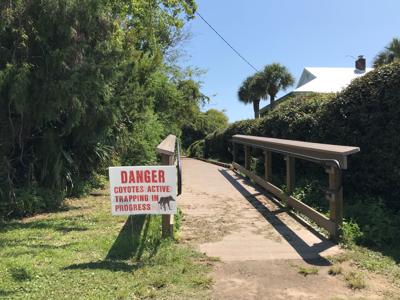ISLE OF PALMS — April saw two more dogs attacked by coyotes on the beach. The incidents have renewed calls for the city to deal with the coyote population.
An Isle of Palms Police Department incident report filed on April 30 detailed a scrimmage between a coyote and a golden retriever.
A woman was walking her two golden retrievers near 34th Avenue around 9 p.m. when a coyote charged at the animals. The owner told police her son was able to corral one dog away from the coyote, but the other dog fought back.
The dog sustained several injuries, according to the report, and was treated at an emergency veterinarian in Mount Pleasant.
Just days before, another man reported on April 21 that his dog was attacked while they were walking down the 37th Avenue beach path. At around 10 a.m., the dog ran after a coyote in the dunes.
The dog yelped and returned to its owner with bites all over its legs and buttocks. According to the report, the dog underwent surgery at an emergency veterinarian clinic.
Dr. Alex MacLean, the medical director for the Veterinary Emergency Group in Mount Pleasant, said her practice has treated five animals for coyote-related injuries, like bites and scratches, since opening its doors in March.
Sgt. Matthew Storen, public information officer for the Isle of Palms Police Department, said this year has been more active than years past.
Only two attacks have been reported to the department, but Storen said there have been 30 coyote sightings turned in this year to date.
On Sullivan’s Island, things seem to be cooling off.
Police Chief Glenn Meadows said coyote activity has decreased significantly lately. Meadows said the town — which has spent over $20,000 on coyote abatement this fiscal year — has removed its traps altogether.
“Because of the lack of sightings on this island, we had Critter Control pull the traps until we start getting more reports. It doesn’t make sense to keep the traps out there and risk catching a domestic animal when we’re not getting complaints of coyote sightings and interactions,” Meadows said.
Meadows said there were four confirmed coyote sightings in 2024 to date, and two attacks, including a woman whose 75-pound dog was ambushed by three coyotes. Fifteen coyote sightings on Sullivan’s Island were reported in 2023.
Both the Isle of Palms and Sullivan’s Island contracted with Critter Control, a wildlife removal service, to place coyote traps around the islands.
Scott Frisbie, who works for Critter Control, said catching a coyote isn’t as easy as it seems.
They don’t tend to stick around in one area, instead traveling up and down the dunes. When they seem to be gone from one place, they’ll pop up in another place, Frisbie said.
Trappers rely on reported sightings to better target their efforts. Storen said the city regularly updates Critter Control on where the most recent sightings have occurred so they can stay on top of the pack.
“We do catch a good bit of them, but they move a lot so you have to move with them to stay with them,” Frisbie said.
The traps have to be checked every 24 hours, and depending on the season, the bait used in the traps must be changed.
Storen said there are six traps in the area surrounding the 34A beach access on the Isle of Palms, where the golden retriever was attacked.
But trapping isn’t a cure-all for the coyote problem. Traps caught four coyotes on Sullivan’s Island this year. Storen said when the Isle of Palms previously utilized coyote traps, the results weren’t great.
“It’s just not realistic that we’re going to be able to trap all of them but we want to try to at least mitigate this situation,” Storen said.
Though not an invasive species, coyotes were illegally brought to South Carolina in the 1970s, by houndsmen, according to the Department of Natural Resources.
This importation, along with the animal’s natural immigration, allowed the population to quickly establish in the state, and now the animal can be found in every county in South Carolina.










